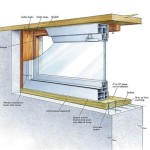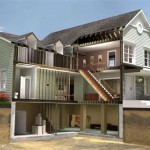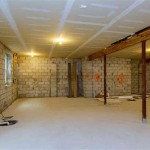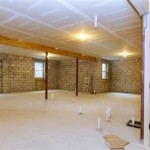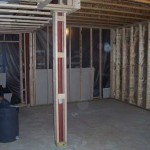How To Warm A Basement In The Winter
Basements, often the lowest level of a dwelling, are particularly susceptible to cold temperatures during the winter months. This inherent chill stems from several factors, including the basement's proximity to the cold ground, concrete construction materials that readily conduct heat away from the interior, and often, inadequate insulation. Addressing the issue of a cold basement is crucial not only for comfort but also for preventing potential problems such as frozen pipes, mold growth due to condensation, and increased energy bills as the home's heating system struggles to maintain a consistent temperature throughout the house.
Successfully warming a basement in the winter entails a multi-faceted approach. This approach involves identifying the sources of heat loss, implementing appropriate insulation strategies, and considering supplementary heating options. Addressing each of these aspects will contribute to creating a more comfortable and energy-efficient basement environment.
Insulating the Basement
Insulation is paramount in minimizing heat loss and maintaining a more consistent temperature within the basement. The specific type of insulation and the installation method will depend on the basement's construction, the presence of moisture, and budget constraints. Common areas to insulate include basement walls, rim joists, and the basement ceiling.
Basement Walls: Insulating basement walls is arguably the most impactful step in warming the space. Options for insulating basement walls include rigid foam insulation, fiberglass batt insulation (with proper moisture protection), and spray foam insulation. Rigid foam insulation is often preferred as it offers a good R-value (a measure of thermal resistance) and is resistant to moisture. It can be installed directly against the concrete walls and then covered with drywall for a finished appearance. Fiberglass batt insulation, while less expensive, requires careful installation with a vapor barrier to prevent moisture from seeping into the insulation and compromising its effectiveness. Spray foam insulation provides excellent insulation and also acts as an air sealant, filling in cracks and gaps that can contribute to heat loss. However, it is typically more expensive than other options and requires professional installation.
Rim Joists: Rim joists, the wooden framing members located above the foundation wall, are a significant source of heat loss. These areas are particularly vulnerable because they are often uninsulated and can allow cold air to infiltrate the basement. Insulating the rim joists is relatively straightforward and can be accomplished using spray foam insulation or fiberglass batt insulation. When using fiberglass batts, ensure they are properly fitted and sealed to prevent air leaks. Spray foam insulation is highly effective in this area as it expands to fill all gaps and create an airtight seal.
Basement Ceiling: While not as critical as insulating the walls, insulating the basement ceiling can still contribute to a warmer basement. This is particularly important if the floor above the basement is not well-insulated. Fiberglass batt insulation is a common choice for insulating the basement ceiling. The batts can be installed between the floor joists and held in place with wire mesh or furring strips. Alternatively, rigid foam insulation can be used, especially if there is limited headroom. Proper ventilation is crucial when insulating the basement ceiling to prevent moisture buildup and potential mold growth.
Addressing Air Leaks
Air leaks are a common cause of cold basements. Even with adequate insulation, drafts from cracks and gaps around windows, doors, and pipes can significantly lower the temperature. Identifying and sealing these air leaks is essential for maximizing the effectiveness of insulation efforts.
Caulking and Weatherstripping: Applying caulk to cracks and gaps around windows and doors is a simple yet effective way to reduce air leaks. Choose a high-quality caulk that is designed for exterior use and can withstand temperature fluctuations. Weatherstripping should be installed around the edges of doors and windows to create a tight seal when they are closed. Various types of weatherstripping are available, including foam, felt, and rubber, each offering different levels of effectiveness and durability.
Sealing Penetrations: Pipes, wires, and ducts that pass through the basement walls or ceiling often have gaps around them that allow air to leak in. These penetrations should be sealed with expanding foam or caulk. Ensure the sealant is appropriate for the material being sealed and can withstand the temperatures in the basement. For larger gaps, consider using backer rod before applying sealant to provide a more solid and durable seal.
Checking the Foundation: Inspect the foundation walls for cracks and gaps that could be allowing cold air and moisture to enter the basement. Small cracks can be sealed with concrete crack filler. Larger cracks may require professional repair to ensure the structural integrity of the foundation. Addressing foundation issues not only helps to warm the basement but also prevents further damage to the foundation over time.
Supplementary Heating Options
In addition to insulation and air sealing, supplementary heating options can provide additional warmth to the basement, particularly during the coldest months. The choice of heating method will depend on factors such as the size of the basement, the level of insulation, and personal preferences.
Space Heaters: Space heaters are a portable and relatively inexpensive option for providing supplemental heat to specific areas of the basement. Electric space heaters are the most common type but should be used with caution. Ensure the heater is placed on a level surface, away from flammable materials, and is equipped with safety features such as an automatic shut-off switch. Consider using a space heater with a thermostat to maintain a consistent temperature and prevent overheating. Oil-filled radiator heaters are a safer alternative to traditional electric space heaters as they do not have exposed heating elements and provide more consistent, radiant heat.
Radiant Floor Heating: Radiant floor heating involves installing heating elements beneath the basement floor to provide warmth directly from the floor surface. This is a more permanent and energy-efficient heating solution compared to space heaters. Radiant floor heating can be installed using electric heating cables or hydronic (water-based) systems. Electric systems are simpler to install but can be more expensive to operate, while hydronic systems require a boiler or water heater but offer lower operating costs. Radiant floor heating provides even heat distribution and can create a comfortable and energy-efficient basement environment.
Ductless Mini-Split Systems: Ductless mini-split systems are a versatile heating and cooling option for basements. These systems consist of an outdoor compressor unit and an indoor air handler unit that is mounted on the wall. Ductless mini-split systems are energy-efficient and can provide both heating and cooling. They are also relatively easy to install, requiring only a small hole in the wall to connect the indoor and outdoor units. Ductless mini-split systems offer precise temperature control and can be a cost-effective solution for heating and cooling a basement.
Extending Central Heating: If the home has a central heating system, such as a forced-air furnace or boiler, it may be possible to extend the ductwork or piping to the basement. This would allow the basement to be heated by the existing system. However, it is important to ensure that the existing heating system has sufficient capacity to heat the additional space. Extending central heating may require professional installation and could involve significant modifications to the existing ductwork or piping.
Managing humidity levels within the basement is also an important consideration when aiming for warmth and comfort. High humidity can exacerbate the feeling of coldness and contribute to mold growth. A dehumidifier can be used to remove excess moisture from the air, creating a more comfortable and healthier environment. Consider choosing a dehumidifier with an automatic humidistat to maintain a consistent humidity level.
Additionally, proper ventilation is crucial for preventing moisture buildup and maintaining air quality in the basement. Ensure that the basement has adequate ventilation by opening windows or using a ventilation fan. Proper ventilation helps to remove stale air and moisture, reducing the risk of mold growth and improving the overall comfort of the basement.
Choosing appropriate flooring materials can also contribute to a warmer basement. Concrete floors are naturally cold, so covering them with carpeting, rugs, or insulated flooring can help to retain heat. Consider using area rugs or carpeting in high-traffic areas to provide additional warmth and comfort. Insulated flooring systems, such as interlocking foam tiles or subfloor panels, can provide a more effective barrier against the cold concrete floor.
By implementing a combination of these strategies, it is possible to significantly improve the warmth and comfort of a basement during the winter months. Addressing insulation, air leaks, supplementary heating, humidity control, ventilation, and flooring choices will all contribute to creating a more livable and energy-efficient basement environment.

Keep Your Basement Warm During Winter Crew Construction Restoration

Keep Your Basement Warm In The Winter With These Tips H

Keeping Your Basement Warm During The Winter Tips And Tricks Waterproofing Basements More Foundation Repair Egress Window Pros

How To Keep Your Basement Warm In The Winter Aire Serv

10 Basement Heating Options To Keep You Warm Cozy In Winter

5 Tips For Heating A Basement In The Winter Youtube

Is Your Basement Freezing How To Keep Warm This Winter Titan Heating Cooling

How To Keep Your Basement Warm In The Winter Link Climatecare

8 Best Basement Heaters For A Warm And Cozy Winter

How To Warm A Basement In The Winter 2025 Www Edv No

